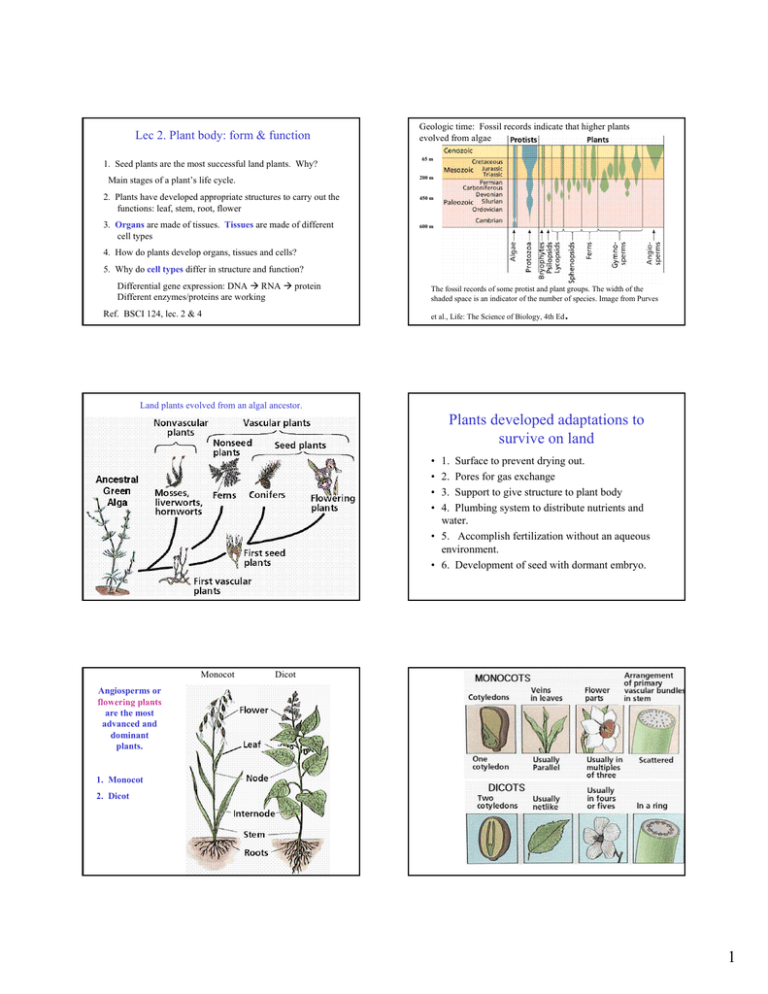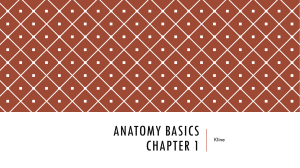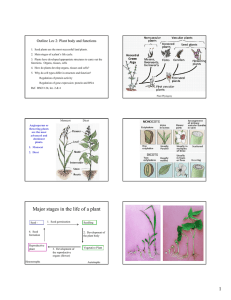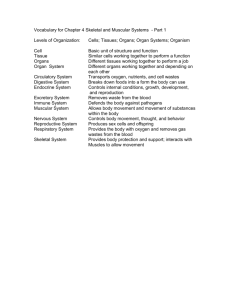Lec 2. Plant body: form & function
advertisement

Lec 2. Plant body: form & function 1. Seed plants are the most successful land plants. Why? Geologic time: Fossil records indicate that higher plants evolved from algae 65 m 200 m Main stages of a plant’s life cycle. 2. Plants have developed appropriate structures to carry out the functions: leaf, stem, root, flower 450 m 3. Organs are made of tissues. Tissues are made of different cell types 600 m 4. How do plants develop organs, tissues and cells? 5. Why do cell types differ in structure and function? Differential gene expression: DNA Æ RNA Æ protein Different enzymes/proteins are working Ref. BSCI 124, lec. 2 & 4 The fossil records of some protist and plant groups. The width of the shaded space is an indicator of the number of species. Image from Purves et al., Life: The Science of Biology, 4th Ed . Land plants evolved from an algal ancestor. Plants developed adaptations to survive on land • • • • 1. Surface to prevent drying out. 2. Pores for gas exchange 3. Support to give structure to plant body 4. Plumbing system to distribute nutrients and water. • 5. Accomplish fertilization without an aqueous environment. • 6. Development of seed with dormant embryo. Monocot Dicot Angiosperms or flowering plants are the most advanced and dominant plants. 1. Monocot 2. Dicot 1 Seed Germination Major stages in the life of a plant Seed - 1. Seed germination Seedling 4. Seed formation Reproductive plant 2. Development of the plant body Vegetative Plant 3. Development of the reproductive organs (flower) Heterotrophs Autotrophs Development of the vegetative plant body. Plants develop appropriate structures to carry out special functions. Veg. plant body is made of 3 organs: Reproductive development involves formation of flowers 1. Sepal 2. Petal 3. Stamen: male organ 4. Pistil: female organ •leaf •Stem •root Reproductive development involves formation of flowers Stamen: male organ Fig. 1-2. Taiz In corn, male and female flowers are separated. Pistil: female organ Pollination Fertilization Insect or bird pollinated flowers are colored and fragrant. 2 Reproductive Organs Grass Flower: Wheat Flower: produces egg and sperm promote pollination and fertilization 4 organs: Sepal •Sepals •Petals = Petal •Stamens •pistils Wheat spikelet Wind pollinated flowers are not showy Fruit: protects embryo from harsh environment, protects embryo from animals promotes seed dispersion ? Difference between fruit and seed? 1. A plant body is made up of cells, tissues and organs. ORGANS: Veg. body is made up of three organs: function? leaf, stem root Reproductive organs are: flower fruit Tissues: Each organ is made of several tissues. A tissue has a particular function. 1. dermal 2. ground 3. vascular [4. Meristem] Cell types Tissues 1. dermal 2. ground 3. vascular Main function is ? 3 LS of Root shows different growth zones Cell types: A tissue consists of one or more cell types. 1. Dermal tissue includes the epidermis, guard cell (leaf) 2. Ground tissue: includes cortex, mesophyll parenchyma 3. Vascular tissue includes xylem tracheids, phloem sieve tube, companion cells Cells are grouped in tissues and several tissues make up an organ. The ability of plants to grow and develop depends on the ability of individual cells to divide, differentiate and to carry out their intended functions. Root Cross-Section 4 How do plants develop organs & cell types? Plants development is characterized by permanent embryogeny Meristems: cells can continuously divide Unlike animals, plants can grow indefinitely at the growing tips. • shoot apical meristem • root apical meristem •Shoot apical meristem --->leaf and stem •Root apical meristem --> root Growth and Development includes: •Cambium ---> increase girth of stem •Cell Division •Enlargement (or Elongation) •Differentiation (or specialization) ---> cell types How do roots grow? Shoot apical meristem Floral apical meristem 16-13. Shoot apical meristem 5 Recap Name these foods: Organ? Carrot Spinach Sugar cane Tomato Brocolli Corn on the cob Tissues of a root Why do cell types look and behave differently? Why do cells differ in form and function? 1-10. Differential Gene expression 1-4. Plant cell 6







